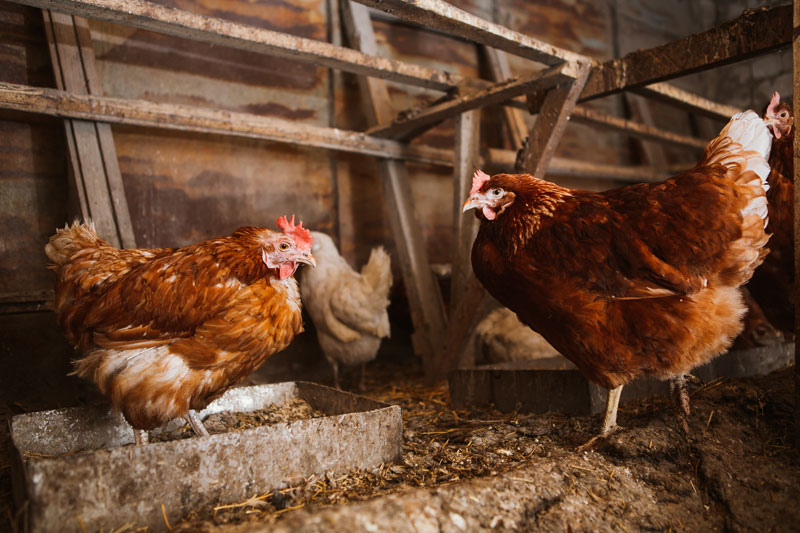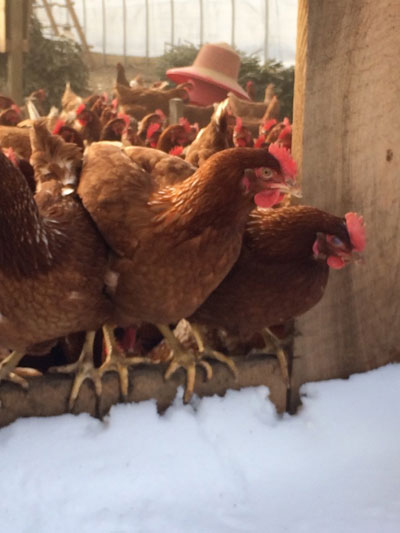Keeping chickens engaged helps avoid naughty behavior.

Specifically, these lady birds are Rhode Island Reds, a fairly common breed of laying hen, and number around three hundred. They live in a hoop house constructed of wood and heavy plastic which covers around 3,000 square feet and includes such accommodations as straw-lined nesting boxes and natural wood roosts. The sides of the hoop house roll up to allow ventilation and extra sunlight, and during most days trap doors are opened to allow the hens free range of the surrounding fields and woods. They should, by any standards, be very happy chickens.
The primary issue at hand arose in mid-January, during a cold spell that prevented the chickens from their usual outdoor wandering. Instead of poking the ground in search of worms, bugs, and other such delicacies, the birds turned to antagonizing one another. Like bored siblings on a road trip, they pecked at one another – generally harmless behavior, until it got out of hand. Chickens tend to emulate the actions of other birds in their flock, from venturing out into alien, snowy fields to attacking the contents of a cracked egg. The sight of blood on their companions, not uncommon in younger birds as they begin to lay, provokes a flock-wide frenzy that can quickly change a situation from merely uncomfortable to deadly for the bird.
This frenzy of antagonization, known as cannibalism, consists of many birds pecking incessantly at the vent (or cloaca) of the injured bird and can result in permanent reproductive damage and death. Different from the establishment of the pecking order, this process tends to target injured individuals with blood as the primary source of provocation. If noticed early, the injured bird can be removed, cleaned, and returned to the hoop house or coop after recovering enough to escape notice by her peers. However, if such cannibalization is left unchecked in a population of chickens, it can prove highly detrimental to the flock. And so began my attempt to occupy the chickens’ time. To start, I consulted a professor at the University of Connecticut Agricultural Extension. Here’s how the farm’s lead farmer and I applied the advice we received.
[mf_h2 align=”left” transform=”uppercase”]1) Provide an Interesting Environment[/mf_h2]
While unable to allow the lady birds to roam the fields, the primary solution to their pecking problem was to provide sources for scavenging in the hoop houses. Their homes already had a healthy supply of leaf litter on the ground, which was collected and dried in autumn. Leaf litter provides a blanket of insulation, prevents odor in the hoop house, and provides a venue for dust baths – entertainment for both humans and fowl. Most importantly, leaves provide a field for foraging when weather prevented outdoor activity. Similarly, adding other natural distractions helped maintain a stimulating environment. The farm was able to obtain several discarded Christmas trees, which improved the smell of the hoop houses and provided protective hiding spots for injured birds. Perches, with abundant space for the whole flock, also allow for refuge for injured individuals.
[mf_h2 align=”left” transform=”uppercase”]2) Keep Them Fed[/mf_h2]
Maintaining constant food and water sources for the flock helped alleviate agitation, hunger, and boredom. The laying hens were fed both morning and night – a grain mixture and a small supplement of cracked corn respectively – with some residual grains in the leaf litter providing fodder for foragers. Chickens also enjoy food scraps. This flock particularly found pleasure in potato peelings and leafy greens which, when given, they would use for a flock-wide game of chicken chase. The momentary victor would grip the prize in their beak while a hoard of hens followed quickly at its heels. The ensuing melee resembling, once again, siblings engaged in a petty, playful tussle.
More delicate leafy greens such as a kale and collards provided momentary excitement, but for extended entertainment, cabbage proved the most beneficial. Sliced into quarters for easily accessible leaves, whole heads were hung from the ceiling of the hoop house to provide a more constant source of scraps.
[mf_h2 align=”left” transform=”uppercase”]3) Monitor the Flock[/mf_h2]
Providing entertainment certainly helps prevent boredom in chickens, as it does humans, but persistent vigilance most effectively prevents the ultimate outcomes of cannibalism when it really becomes a problem. Removing injured individuals immediately reduces the flock’s reaction, hopefully before they inflict permanent damage. Awareness of activity in the hoop house or coop also permits the observation and removal of particularly antagonistic individuals, who incite the large-scale attacks. Checking the chickens regularly reduces bad behavior and provides an opportunity to monitor food and water supply.
Although these suggestions proved largely successful at the small farm where I work, my own experiences are fairly limited. These suggestions are merely meant to point your flock in the right direction if winter humdrums and subsequent cannibalism begin to occur. Depending on environmental stressors and the chickens themselves, flocks react differently to stimuli and these suggestions may require tweaking to suit the birds and encourage fowl play. Always feel free to contact your local extension office for more specific advice.

